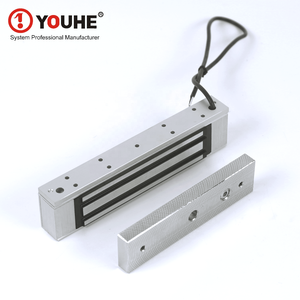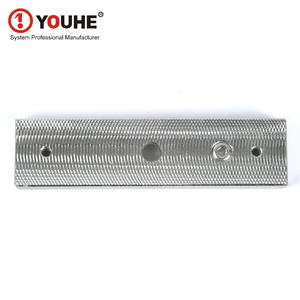
All categories
Featured selections
Trade Assurance
Buyer Central
Help Center
Get the app
Become a supplier

(654 products available)













































Manufacturers develop interlock devices in different types to serve specific functions. Each type finds application in various industries and operational areas, such as construction, manufacturing, and electrical systems.
Mechanical interlock devices
These lock a machine's operation based on the position of its components. They use physical keys, levers, or cams to prevent action when parts do not align correctly. One typical application is in multi-step manufacturing machines. Here, the device ensures one machine part cannot operate until another is complete.
Electrical interlock devices
These prevent electrical equipment from operating under unsafe conditions. They do this by interrupting or controlling electrical circuits. For instance, in a motor control system, an electrical interlock might ensure that a motor cannot start if a protective cover is not in place. These devices are common in control panels and industrial motors.
Programmable interlock devices
These offer flexibility by allowing users to program operational sequences. Thus, their application does not have a one-fits-all solution. Industries can use them to interlock various equipment depending on the operational needs. Their adaptability makes them an appealing choice for complex manufacturing processes with frequently changing operational requirements.
Hydraulic interlock devices
These integrate into hydraulic systems to prevent the machinery's operation if specific conditions are not met. People often see them in construction equipment, ensuring that operators cannot engage high-pressure hydraulic functions unless safety precautions are in place. These devices play a critical role in reducing accidents in heavy machinery.
Key-based interlock devices
These function to allow operations only when specific keys or access credentials are present. The systems use different keys for different operations in complex industrial environments. Thus, they offer hierarchical control over equipment use. These interlocks are popular in chemical plants and facilities dealing with toxic substances, where limited access is vital.
Interlock device manufacturers develop them in ways that serve their intended purpose effectively while maintaining reliability, durability, and ease of use. So this is considering numerous functional, aesthetic, and environmental factors.
Mechanism
People often categorize interlock devices into mechanical, electrical, and software-based categories. For example, mechanical interlocks have keys or lock-and-key systems. Conversely, electrical interlocks use switches and circuit designs to achieve the locking functions. On the other hand, design programmers implement interlocks using software algorithms.
Durability
Manufacturers build interlock devices in such a way as to withstand harsh industrial conditions. So this means that their materials must be corrosion-resistant. Additionally, they use wear-resistant materials. For instance, they use stainless steel, reinforced plastics, and other robust materials in the interlock devices.
Usability
In designing the interlock devices, they should consider the end-users. This means that operating the devices should not be a complicated task. For example, key-based interlocks have different keys that are easy to access and operate. In addition, manufacturers pay close attention to the size of the key. This ensures compatibility with existing systems.
Integration
Interlocking devices often have to work with existing safety systems or machinery. To ensure easy incorporation, manufacturers design interlock devices to be compatible with a wide range of equipment. This means that they can easily integrate with different customers' operating systems.
Ergonomics
Many interlock devices have to be frequently accessed. This is why manufacturers make the devices as user-friendly as possible. They, therefore, design them to have easy-to-handle components. Additionally, they ensure that their displays are clear, and users can easily operate and monitor them.
Size and form factor
People use some interlock devices in tight spaces. That is why their design has to be compact. Even with their small size, they should not be less functional. On the other hand, other devices must be large enough. For instance, in hydraulic systems, the interlocks must be large enough to perform locking functions properly.
With the recent developments towards a greener environment, many device manufacturers are looking for ways to conserve Mother Nature. For instance, they are adopting eco-friendly materials. In addition, they are implementing energy-efficient technologies. This not only reduces the carbon footprint but also supports regulatory compliance.
Interlock devices find numerous applications in various industries. Their primary purpose is to enhance safety, ensure compliance with regulations, and improve operational efficiency across the board.
In these environments, they use interlock devices to protect the workers from hazardous situations. For example, in heavy machinery, people use mechanical interlocks to prevent the operation of equipment when safety guards are removed. These devices reduce the risk of accidents while also ensuring that the equipment only operates under the right safe conditions.
Here, interlock devices help control the use of large machinery. These devices reduce the risk of the equipment's operation without proper safety measures. They also minimize the likelihood of workers bypassing safety protocols. Hence, they protect workers from potential injury and help the sites meet strict regulatory standards.
People use electrical interlocks in electrical panel control systems. These systems, after all, ensure that circuit operations only occur under safe conditions. They also prevent unauthorized access to high-voltage areas. These systems protect workers and facilities from electrical hazards.
Here, people apply key-based interlocks during the vehicle assembly process. Vehicles, after all, require certain steps during manufacturing to be completed before others can begin. Interlock devices ensure that no critical step is skipped or performed out of sequence. This safeguards product quality and reliability.
Chemical companies frequently deploy these devices to control access to areas with toxic substances. Key-based interlocks limit personnel access to only trained and certified individuals. These devices reduce exposure risk, after all, and ensure compliance with safety regulations.
Mining agencies use hydraulic interlocks on heavy mining equipment. These devices prevent the operation of certain controls if safety conditions are not met. They aid in preventing the accidental release of high-pressure systems. The devices, therefore, help reduce accidents and increase operational downtime.
It is imperative that business owners know what goes into interlock device maintenance and repair so as to avoid frequent breakdowns. Besides, a well-maintained device lasts longer. Furthermore, it operates more reliably and safely.
Load capacity
This refers to the device's ability to support the electrical or mechanical load. Thus, go for devices that meet the required load capacity of the application. Using an interlock with different specifications leads to failure.
Response time
Manufacturers measure this using the time between the trigger event and the interlock action. Clients normally require fast response times for critical applications. In such situations, go for a device that has a fast response time. Conversely, others do not mind slower ones for less critical tasks.
Temperature range
Interlock devices normally operate in extreme temperature conditions. This is especially true in industrial areas. That is why clients should ensure to buy those that can function properly in their condition without degradation. Further, they should consider the climate of the environment before selecting the devices.
Material composition
The materials of these devices should be wear-resistant, especially since they are frequently used in industrial setups. Also, since people use them in various environments, select those that can withstand exposure to dust, chemicals, and moisture.
Compatibility
How do the interlock devices interact with the existing equipment? Do they work together seamlessly? Before installation, the staff should ensure that the new interlocks are compatible with existing machinery and safety systems. This will avoid major post-installation changes in the systems.
Access
Some interlock devices require easy access for operation and maintenance. On the other hand, some require limited access. These are often protected by key-based systems. In such situations, always ensure the key holders are easily accessible to have hassle-free operations.
Vibration and shock
Industrial environments frequently use heavy machinery. Thus, interlocks installed on these machines should be able to withstand vibrations and shocks. In the end, this prevents any malfunction due to wear and tear caused by vibrations.
Electrical connections
For electrical interlocks, the installation must guarantee secure electrical connections. Additionally, the devices should ensure insulation to avoid short circuits. There should also be no near proximity to other electrical equipment that poses a risk of interference.
Preventive maintenance
It regularly checks the devices for wear and tear and identifies potential problems before they cause a failure. The maintenance should follow the manufacturer's recommendations. Further, employees should have a periodic inspection and testing schedule to ensure proper functioning.
Lubrication
As mentioned earlier, mechanical interlocks have keys and other moving parts. Thus, regular lubrication of these parts reduces friction and wear. It also helps in preventing rust.
Cleaning
These devices can easily collect dust and debris, especially in industrial environments. This can cause malfunction if not addressed. It is therefore imperative to regularly clean the interlock devices using dry cloths. For the electrical ones, cleaning the contact points improves their function.
Testing
Regular testing, on the other hand, ensures the interlocks work under the right conditions. Conduct function tests to evaluate the device's response to lock and unlock mechanisms. During these tests, look for any inconsistencies or delays in operation.
Inspection for damage
Beyond routine checks, employees should also conduct a thorough inspection for any signs of damage. This includes worn-out electrical interlock switches or rusted mechanical ones. Address these immediately to avoid dangerous situations.
As seen earlier, interlock devices require a lot of maintenance to work effectively and securely. Besides, it ensures there is compliance with safety regulations. Regular inspections, cleaning, testing, and component lubrication keep devices functional. That is why there is a lower risk of device failure and safety breaches happening.
As mentioned earlier, interlock devices have to operate in extreme temperature conditions. That is why selecting those with a proper temperature range ensures optimal functioning. So, in hot environments, the heat can degrade the materials and even the mechanism. Conversely, cold temperatures often result in brittleness. Therefore, a proper temperature range guarantees durability.
People use electrical interlocks mainly in electrical systems. They specifically prevent the operation of machinery when unsafe conditions occur. An example is failure to close circuit protective cover. These devices interrupt electrical circuits to avoid accidents or equipment damage.
Wear and tear happens to every device as time goes by. When interlock devices finally reach the end of their life expectancy, they should be disposed of according to local regulations. Besides, it ensures safe and proper handling of electronic waste. Then, recycling programs should be considered since they recover valuable materials.